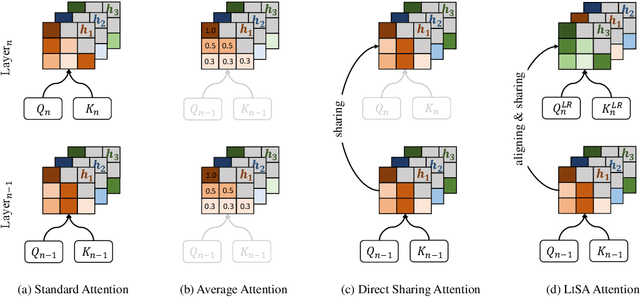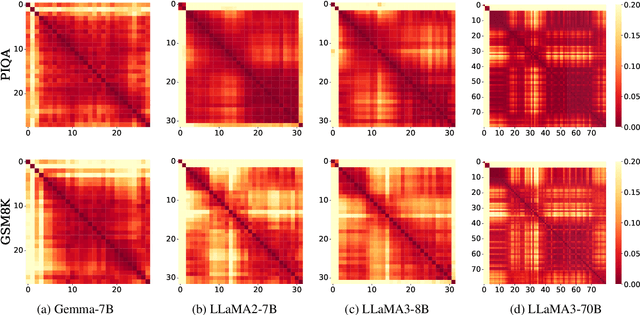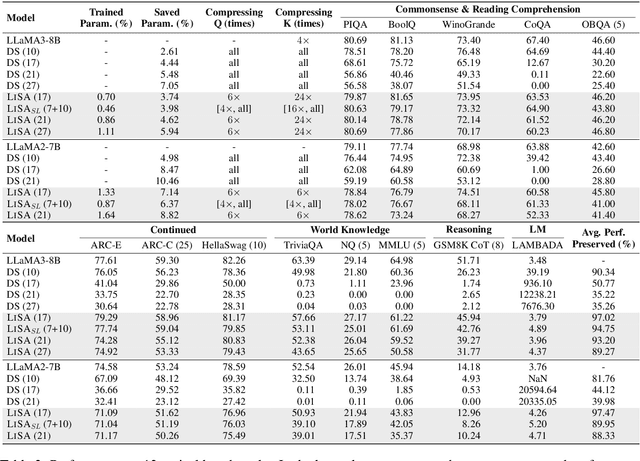Yuzhang Wu
Cross-layer Attention Sharing for Large Language Models
Aug 04, 2024



Abstract:As large language models (LLMs) evolve, the increase in model depth and parameter number leads to substantial redundancy. To enhance the efficiency of the attention mechanism, previous works primarily compress the KV cache or group attention heads, while largely overlooking redundancy between layers. Our comprehensive analyses across various LLMs show that highly similar attention patterns persist within most layers. It's intuitive to save the computation by sharing attention weights across layers. However, further analysis reveals two challenges: (1) Directly sharing the weight matrix without carefully rearranging the attention heads proves to be ineffective; (2) Shallow layers are vulnerable to small deviations in attention weights. Driven by these insights, we introduce LiSA, a lightweight substitute for self-attention in well-trained LLMs. LiSA employs tiny feed-forward networks to align attention heads between adjacent layers and low-rank matrices to approximate differences in layer-wise attention weights. Evaluations encompassing 13 typical benchmarks demonstrate that LiSA maintains high response quality in terms of accuracy and perplexity while reducing redundant attention calculations within 53-84% of the total layers. Our implementations of LiSA achieve a 6X compression of Q and K, with maximum throughput improvements of 19.5% for LLaMA3-8B and 32.3% for LLaMA2-7B.
Translate-and-Revise: Boosting Large Language Models for Constrained Translation
Jul 18, 2024Abstract:Imposing constraints on machine translation systems presents a challenging issue because these systems are not trained to make use of constraints in generating adequate, fluent translations. In this paper, we leverage the capabilities of large language models (LLMs) for constrained translation, given that LLMs can easily adapt to this task by taking translation instructions and constraints as prompts. However, LLMs cannot always guarantee the adequacy of translation, and, in some cases, ignore the given constraints. This is in part because LLMs might be overly confident in their predictions, overriding the influence of the constraints. To overcome this overiding behaviour, we propose to add a revision process that encourages LLMs to correct the outputs by prompting them about the constraints that have not yet been met. We evaluate our approach on four constrained translation tasks, encompassing both lexical and structural constraints in multiple constraint domains. Experiments show 15\% improvement in constraint-based translation accuracy over standard LLMs and the approach also significantly outperforms neural machine translation (NMT) state-of-the-art methods.
Large Language Models are Parallel Multilingual Learners
Mar 14, 2024Abstract:In this study, we reveal an in-context learning (ICL) capability of multilingual large language models (LLMs): by translating the input to several languages, we provide Parallel Input in Multiple Languages (PiM) to LLMs, which significantly enhances their comprehension abilities. To test this capability, we design extensive experiments encompassing 8 typical datasets, 7 languages and 8 state-of-the-art multilingual LLMs. Experimental results show that (1) incorporating more languages help PiM surpass the conventional ICL further; (2) even combining with the translations that are inferior to baseline performance can also help. Moreover, by examining the activated neurons in LLMs, we discover a counterintuitive but interesting phenomenon. Contrary to the common thought that PiM would activate more neurons than monolingual input to leverage knowledge learned from diverse languages, PiM actually inhibits neurons and promotes more precise neuron activation especially when more languages are added. This phenomenon aligns with the neuroscience insight about synaptic pruning, which removes less used neural connections, strengthens remainders, and then enhances brain intelligence.
 Add to Chrome
Add to Chrome Add to Firefox
Add to Firefox Add to Edge
Add to Edge